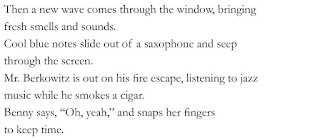Elementary teachers,
Traci Sorell's lyrically beautiful, multi-award-winning We Are Grateful Otsaliheliga (2018) is just what you are looking for.
Summary from the author's website:
Otsaliheliga (oh-jah-LEE-hay-lee-gah) is a word that Cherokee people use to express gratitude. Beginning in the fall with the Cherokee New Year and ending in summer, follow a full Cherokee year of celebrations and experiences. Written by Traci Sorell, a citizen of the Cherokee Nation, and illustrated by Frané Lessac, this nonfiction look at one group of Native Americans is appended with a glossary and the complete Cherokee syllabary, originally created by Sequoyah.
UP FRONT NOTE: There are two main federally-recognized Cherokee tribes. Traci Sorell is from the Oklahoma Cherokee Nation and her book is from that setting, perspective and research. Points in her book may vary from the Eastern Band of Cherokee Indians' culture and history here in North Carolina. Oklahoma and North Carolina teachers and librarians, especially, should be aware of these distinctions. It would be interesting to have students compare and contrast the two through the lens of We Are Grateful.
Teachers,
We Are Grateful Otsaliheliga lends itself to teaching main idea and supporting details (boxes and bullets in the non-fiction reading unit if you use Lucy Calkins' Reading Units of Study) for second through probably fourth grade. You'll find this in
Jennifer Serravallo's Reading Strategies book, Strategy 8.5, Boxes and Bullets. This would be particularly useful for third grade at my school. For kindergarten and first graders, or students who aren't quite ready to determine what a book is mostly about, this is also a good fit for Goal 8.3, Notice What Repeats.
You'll also want to be sure to teach students to analyze the information presented. Your students can critically analyze the traits the author writes about the Cherokee, the take-away, and why the author believes this story was important to write. In the Reading Strategies book, Strategy 8.15, Why Does the Story Matter? will help you do that.
Additionally, this is a great book to teach text structure because of its seasonal, cyclical structure with plenty of text feature clues. This text could be either description structure (main idea/detail) or sequence but as a circle, not a timeline.
 |
I love illustrator Lessac's four-season tree on the opening page.
This page orients readers to the rest of the book. |
 |
The header (top left) makes this an easy model for text structure.
At bottom right, this pronunciation guide is just one of the text features. |
All that being said, this is clearly a book elementary teachers will want to use at Thanksgiving
in place of problematic books that promote stereotypes but are so commonly used at that time.
We Are Grateful is an #OwnVoices accurate representation of Native life. The author refers to the Cherokee in the present-tense, not as extinct or stuck in history. The illustrator's art also depicts contemporary Native people. And the theme is one that we all want to teach young students: gratitude.
While I would never want to pigeon-hole this book as a 'Thanksgiving book', it really is an excellent substitute for books that we may have used for years, but that actually promote stereotypes.
For more information on accurate teaching about Thanksgiving, please see the North Carolina State Advisory Council on Indian Education's
Teaching About Thanksgiving page.
If you are a teacher in North Carolina, the entire
SACIE Culturally Responsive Instructional Resources website was made into a for-credit pd module two years ago. You can access it the same way you access your PDP. NCEdCloud -->NCEES. Then Professional Development tab at the top, then Course Search for #8048 Culturally Responsive Teaching About American Indians: Self-Paced. Please take this course! Huge amount of learning resources that will pay off in your classroom. Plus, you can do it in your pjs. 😉
For more information (you can even plug a book title into the search bar) on kidlit and accurate Native representation, please see Debbie Reese's amazing blog,
American Indians in Children's Literature.
Teachers and librarians, please make sure this book is in your school!
 |
| Men cuddling babies? Yes, please! |
















